Using FT-MS to Detect Indoor Chemical Contamination
Special Issues
A transportable miniature Fourier-transform ion cyclotron resonance mass spectrometer is used to identify chemical species and remove isobaric interferences in gas analysis. Experimental results use real time direct analysis without the need for additional separation.
Anovel Fourier-transform-mass spectrometry (FT-MS) system based upon a permanent magnet recently has been developed. Pumped solely by an ion getter pump, the system is ionized internally and designed to withstand agents of a highly corrosive nature that typically would exhibit extremely adverse affects in most mass spectrometers. The system is both qualitative and quantitative in nature (1). The Quantra FTMS (Siemens Applied Automation, Bartlesville, OK) was used to investigate building air and chemical contamination by connecting the system to a plant air exchanger.
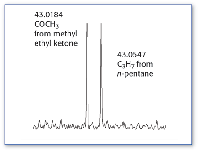
Figure 1. MIMS data.
Air exchangers can circulate, filter, heat, cool, and recombine indoor air with fresh air. The return side of these air handlers can be considered an ideal location for a chemical contaminant analyzer. Circulation through the filter located at the return in essence forms a concentration step. Chemical contaminants will be at a higher concentration in the return vent when compared to the average room concentration. This concentration can be embellished further with an adsorption or cryotrapping stage in the analysis, prior to introduction to the instrument.
Experimental
A simple gas sampling system was placed inside a McQuay LSL106 "Seasonvent" air exchanger (Mcquay-Perfex, Minneapolis, MN). The equipment is typical of a small plant air exchanger and is one of 16 used in the Siemens facility in Bartlesville, OK.
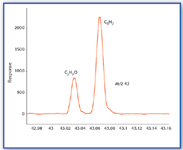
Figure 2. Fermentation data.
The exchanger services a room with a volume of approximately 200,000 L. At a rate of 2576 CFM, the room air supply will be replenished every 5–10 min.
The Quantra was connected to the Air exchanger using a simple PTFE tube. The mini FT-MS system was wheeled to the sampling system and allowed to analyze the contents of the air handler return vent. Because the return vent is in a partial vacuum, it was necessary to use a small vacuum pump to equalize the pressure and create a flow through the mass spectrometer. Various pumps have been used successfully, including small aquarium pumps. Chemicals having a wide variety of volatility were released into an unused portion of the facility serviced by the air-handling unit.
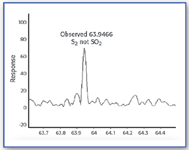
Figure 3. Fermentation data.
Results are presented here using real time direct analysis. Use of high resolution, high mass accuracy measurement capability minimizes interferences from isobars. No additional separation was required to identify the fragments detected. The mini FT-MS system is capable of parts-per-million limits of detection (LOD) in real time. Test results with a range of trapping media were presented at the 2004 ASMS conference (2), in which the Quantra exhibited an LOD in the parts-per-billion range.
The Quantra has been used to identify chemical species and remove isobaric interferences in highly complex head space analyses such as cigarette smoke, membrane introduction mass spectrometry (MIMS) (Figure 1), and fermentation studies (Figures 2 and 3). An air exchanger analysis can be viewed as similar to these applications (3).
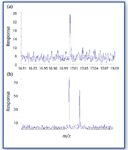
Figure 4. (a) Blank OH only. (b) OH and NH3.
Results
The first chemical released in the air exchanger study was ammonia. A capful of Parson's Ammonia Cleaner was released in the adjoining room. Figure 4a shows the blank, with only
m/z
17 from normal air water background (OH,
m/z
17.0027). Figure 4b shows the presence of a second peak — ammonia (NH
3
at
m/z
17.0065).
Next, trifluoroethane (C2H3F3, molecular weight 84.0186) was released in a series of 1-s "blasts" from an aerosol container, m/z 69 was monitored (CF3) as seen in Figures 5a and 5b.
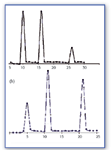
Figure 5. Three 1-s "blasts" of trifluoroethane m/z 69 monitored.
The third peak seen in Figure 5a, and the first peak in Figure 5b, exhibit a somewhat lower response; this is thought to be due to duty cycle. A fast moving transient peak might be partially lost. The Fourier transform and concurrent system "overhead" adds approximately 5 s to the total analysis time. Thus, 10 s of data collection and 5 s of "overhead" will yield a 15-s analysis time and a duty cycle in the 60% or less range, because the data collection stage itself is not 100% efficient.
Longer co-addition routines will increase the apparent efficiency of duty cycle but also will increase the total cycle time. Building air or chemical contamination will not likely be seen as fast transient peaks, but rather should be longer term or steady state in composition.
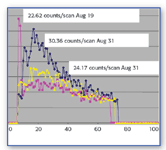
Figure 6. Integration data collected two weeks apart.
In an attempt to determine system stability two sets of data were acquired two weeks apart. Identical experiments were performed. The peak results and integration data are seen as 22.62 counts (per scan), 30.36 counts, 24.17 counts in measurements made two weeks apart (Figure 6).
In conclusion, it was found that the mini FTMS Quantra system readily identified chemicals released in the parts-per-million range in real time, and could, by use of high resolution and accurate mass measurement resolve isobaric interferences. This was seen in the case of water and ammonia. Additional tests on hydrocarbons and oxygenates also were performed, and have been presented at the 2003 ASMS conference (4), again with the species being resolved completely. Lower limits of detection can be achieved with the use of preconcentration techniques such as cryotrapping and adsorption-desorption trapping.
References
1. Method, System and Device for Performing Quantitative Analysis Using an FTMS; U.S. patent no 6.822.223, published 11/23/04. Siemens Applied Automation.
2. W. Rimkus, D. Davis, and K. Gallaher, "Cryo and Absorption trapping on a transportable miniature FTMS," 2004 ASMS conference proceedings.
3. W. Rimkus, D. Davis, and K. Gallaher, "Analysis Of Fermentation Off-Gas Using A High-Resolution, Exact-Mass Mass Spectrometer," 2003 IFPAC conference proceeding.
4. W. Rimkus, D. Davis, and K. Gallaher, "Novel Miniature FTMS for Analysis of Corrosives and Chemical Warfare Agents," 2003 ASMS conference proceedings.
Wayne Rimkus is sales manager for the Quantra FTMS at Siemens Applied Automation (Bartlesville, OK; www.sea.siemens.com). E-mail: Wayne.Rimkus@siemens.com.
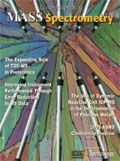
High-Speed Laser MS for Precise, Prep-Free Environmental Particle Tracking
April 21st 2025Scientists at Oak Ridge National Laboratory have demonstrated that a fast, laser-based mass spectrometry method—LA-ICP-TOF-MS—can accurately detect and identify airborne environmental particles, including toxic metal particles like ruthenium, without the need for complex sample preparation. The work offers a breakthrough in rapid, high-resolution analysis of environmental pollutants.
The Fundamental Role of Advanced Hyphenated Techniques in Lithium-Ion Battery Research
December 4th 2024Spectroscopy spoke with Uwe Karst, a full professor at the University of Münster in the Institute of Inorganic and Analytical Chemistry, to discuss his research on hyphenated analytical techniques in battery research.
Mass Spectrometry for Forensic Analysis: An Interview with Glen Jackson
November 27th 2024As part of “The Future of Forensic Analysis” content series, Spectroscopy sat down with Glen P. Jackson of West Virginia University to talk about the historical development of mass spectrometry in forensic analysis.
Detecting Cancer Biomarkers in Canines: An Interview with Landulfo Silveira Jr.
November 5th 2024Spectroscopy sat down with Landulfo Silveira Jr. of Universidade Anhembi Morumbi-UAM and Center for Innovation, Technology and Education-CITÉ (São Paulo, Brazil) to talk about his team’s latest research using Raman spectroscopy to detect biomarkers of cancer in canine sera.